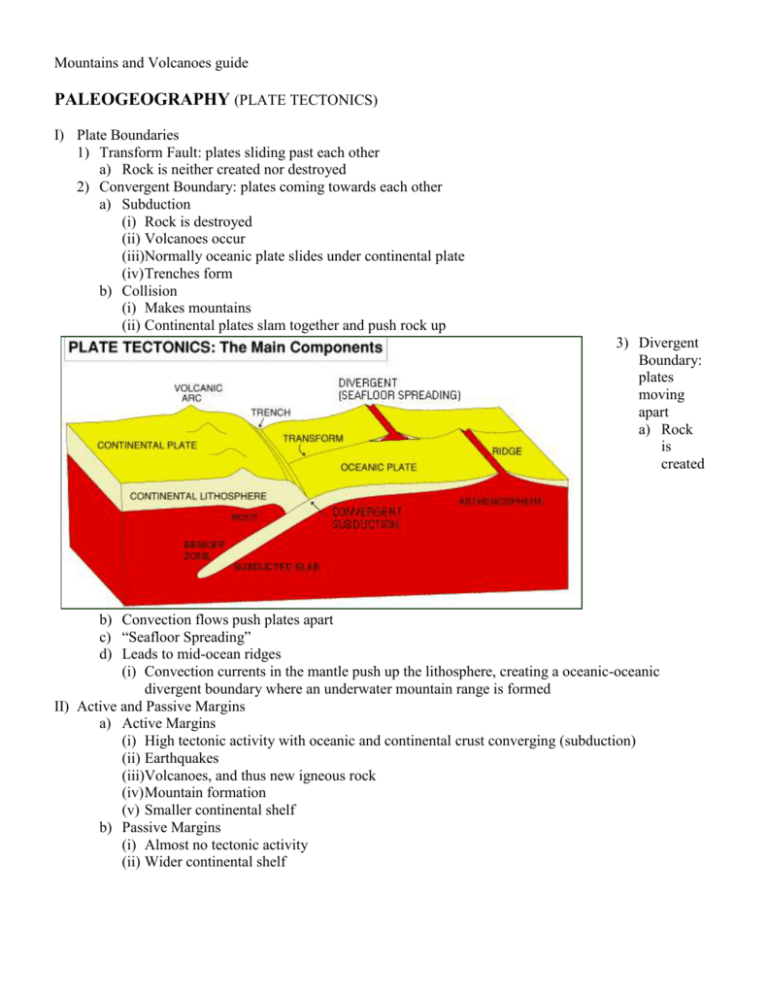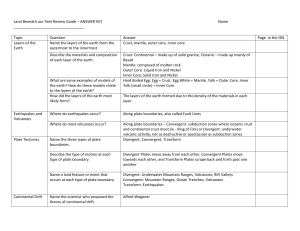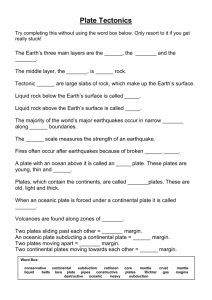Mountains and Volcanoes guide
advertisement

Mountains and Volcanoes guide PALEOGEOGRAPHY (PLATE TECTONICS) I) Plate Boundaries 1) Transform Fault: plates sliding past each other a) Rock is neither created nor destroyed 2) Convergent Boundary: plates coming towards each other a) Subduction (i) Rock is destroyed (ii) Volcanoes occur (iii)Normally oceanic plate slides under continental plate (iv) Trenches form b) Collision (i) Makes mountains (ii) Continental plates slam together and push rock up 3) Divergent Boundary: plates moving apart a) Rock is created b) Convection flows push plates apart c) “Seafloor Spreading” d) Leads to mid-ocean ridges (i) Convection currents in the mantle push up the lithosphere, creating a oceanic-oceanic divergent boundary where an underwater mountain range is formed II) Active and Passive Margins a) Active Margins (i) High tectonic activity with oceanic and continental crust converging (subduction) (ii) Earthquakes (iii)Volcanoes, and thus new igneous rock (iv) Mountain formation (v) Smaller continental shelf b) Passive Margins (i) Almost no tectonic activity (ii) Wider continental shelf III) Phenomena 1) Volcanoes a) Volcano Arcs (i) Form island arcs when subduction increases pressure on magma, which makes volcanoes in the crust (ex. Mariana Islands in the Pacific, and Aleutian Islands) b) Hotspots (i) Locations that have active volcanoes for a long time; as plates pass over hotspots chains of volcanoes form (ex. Hawaii and Galapagos Islands) (ii) May be caused by mantle plumes (narrow vertical convective streams of magma from deep in the asthenosphere) 2) Earthquakes a) Elastic Rebound Theory (i) Earthquakes result from plates slipping past each other after pressure has built up too much (shallow earthquakes) b) Richter Scale: magnitude (energy released) of earthquake through use of a seismograph c) Seismicity: frequency, magnitude, and distribution of earthquakes d) Benioff Zones – 1954 – Hugo Benioff, Kiyoo Wadati (i) Deep, seismically active, subductive boundary zone caused by the bending and extending of oceanic crust deep below the surface e) Focus: point at which an earthquake originates f) Epicenter: point directly above an earthquake’s focus 3) Rifts a) Crust is pulled apart, resulting in faults and fractures that can become rift valleys; consists of horsts (high spots) and grabens (low spots) 4) Layers of the Earth a) Mechanical: inner core, outer core, lower mantle, asthenosphere, lithosphere b) Compositional: core, mantle, crust c) Mohorovicic discontinuity (“Moho”): boundary between crust and mantle that appears as a difference in seismic wave period as it passes through the boundary 5) Plate Types a) Ocean Plates (i) Denser basalt, average 10 km thick b) Continental Plates (i) Less dense granite, average 20-80 km thick 6) Theory of Plate Tectonics – 1960’s a) Pieces of lithosphere (plates) float on asthenosphere and shape the Earth at a speed of 1-10 cm per year b) Tectonism: deformation of Earth’s crust c) Plate movement is caused by thermal convection of the asthenosphere 7) Evidence a) Bathymetry (sea-floor mapping) & Topography b) Magnetic Stripes/Anomalies (from magnetic reversals) (i) Minerals align themselves with the direction of magnetic field and are crystallized in that position, instruments measure this change in direction, Earth’s magnetic field reverses poles sometimes c) Measured Plate Movement d) Matching Coastlines e) Fossil Records 8) Continental Drift – 1915 – Alfred Wegener a) Pangaea (Greek: “all the land”) super continent 200 million years ago IV) Other 1) Pacific Ocean is currently shrinking 2) Wilson Cycle: different stages that lead to changes in ocean basins a) Embryonic: rift valley forms as continent begins to split b) Juvenile: sea floor basalts begin forming as continental sections diverge c) Mature: broad ocean basin widens, trenches develop, and Subduction begins d) Declining: Subduction eliminates much of sea floor and oceanic ridge e) Terminal: last of the sea floor is eliminated and contents collide forming continental mountain chain








